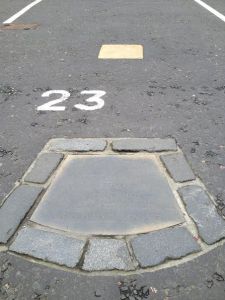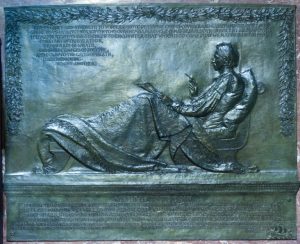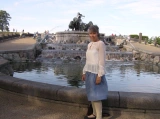St Giles’ Cathedral in Edinburgh
This summer my husband and I spent six days in Edinburgh and today I found a leaflet on St Giles’ Cathedral on the table waiting for being put somewhere.
I remembered that I was drawn to the big church in the middle of the Old Town, and even though we went in twice to see it, I realise that I missed seeing a lot. It’s often so you go in and you don’t know what to chose to see. It is an incredible thought that people have been in such an old building for nearly a thousand years! A lot of knowledge can be found at the St Giles’ webpage. It is also known as the High Kirk of Edinburgh! In English, the word for church is “Kirke”. The outstanding stained glass windows are from the 19th and 20th centuries. They are difficult to show on photos.
The Cathedral stands on the Royal Mile between Edinburgh Castle and the Palace of Holyroodhouse
the area just outside takes you back to the old days where quick executions and other punishments were entertainments in everyday life.
From the leaflet
St Giles was a prince born in Athens around 650 AD. He went to France and became a hermit in the forests around Nimes. Legend says that one day King Wamba of the Goths was hunting and shot an arrow at a deer St Giles had tamed. To save his companion, st Giles blocked the shaft with his hand, hence depictions of St Giles with an arrow through his hand. Later, he became the patron saint of lepers and cripples.
More information on the leaflet:
The Cathedral dates from 12th century (Norman architecture) but was rebuilt in a Gothic style in the 14th to 16th century.
Built as a Catholic Church, the cathedral became Presbyterian after the Scottish Reformation (c.1560), with John Knox being the first Protestant minister.
Behind the Cathedral, at a parking lot, there is a stone that tells us that the grave of the famous John Knox is here. The typical English sense of humour.

st-Giles-john-Knox-parking-lot
Edinburgh is renowned for their poets and writers, and you can see a relief bronze portrait of the writer Robert Louis Stevenson (1850-1894) He was sick all his short life but managed to travel a lot despite that.

Stevenson Memorial From the St Giles’ homepage
We got the idea to visit Edinburgh because of one painting by Vermeer on an exhibition at the Queen’s Palace of Holyroodhouse. We got so much more though that picture really was worth the travel.
Categories: Edinburgh, Historical issues, Travelling










An interesting memory of your stay, Maria, and some lovely photos. Did you know that the German for ‘church’ is ‘kirche?’ There seems to be a common linguistic root here!
LikeLike
Yes Clive! I know that and like linguistics very much. Latin was my favorite subject at school though it was so difficult. But I learnt so much about the origin of words. But the Vikings have influenced a lot too
LikeLiked by 1 person
I studied Latin too, and it taught me a lot about modern day languages. You’re right about the Viking influence, particularly in Northern Europe. English shows many influences from both – hardly surprising, really, as the Romans and Vikings both came to visit us 😊
LikeLiked by 1 person
I remember how scared I was when my English “dad” in Manchester showed me a big painting in the city hall of Vikings being overthrown by the British. I was fifteen and didn’t know we were so unpopular 🙄
LikeLiked by 1 person
Any uninvited visitor tends to be unpopular! But it’s an important part of our history, particularly for Scotland, the Hebrides and northern England. Here in the south we mostly had the Romans and the French to contend with, though the Vikings made their mark here too 😊
LikeLike
I understand so well. I resented German for many years and though I was taught German for five years I didn’t learn much. I always thought of my mother’s comments on how she loaded their singing in the streets in their green uniforms and ugly helmets
LikeLiked by 1 person
I can understand that, it’s much more recent than the Romans and Vikings were for us. Now they are an integral part of our history and culture. It’s a cliché but time is a great healer.
LikeLiked by 1 person
I remember this church and the Royal Mile very well. I, also find myself almost overwhelmed thinking about all the lives who had walked the same steps I were taking and sitting and praying in the same Cathedral. It is humbling.
LikeLiked by 1 person
You express the feeling so fine Bernadette. It is overwhelming to know that people have live difficult lives and had their time in those places
LikeLiked by 1 person
A beautiful educational post again. I didn’t know that R.L. Stevenson was sick. He wrote a poem ‘In the States’ about America that ends, ‘Youth shall grow great and strong and free, But age must still decay; Tomorrow for the States — for me, England and yesterday,”
LikeLiked by 1 person
Thank you Paula. The visit to Edinburgh opened my eyes for him and other writers from the city. He was sick all his childhood and often as an adult too. When he wrote the children poems that I mentioned in the post on the unseen friend he was so ill that he could only write about his childhood and the sweet nanny who stayed up with him throughout difficult nights of coughing
LikeLike
Maria, What a glorious place, and such lovely pictures. My husband is a Presbyterian minister and I love that John Knox is buried in the parking lot! So glad you and your husband enjoyed yourselves! Jo
LikeLiked by 1 person
We also found a stone for Adam Smith a famous economist and philosopher in the pavement in front of another old church in Canon Gate
LikeLiked by 1 person